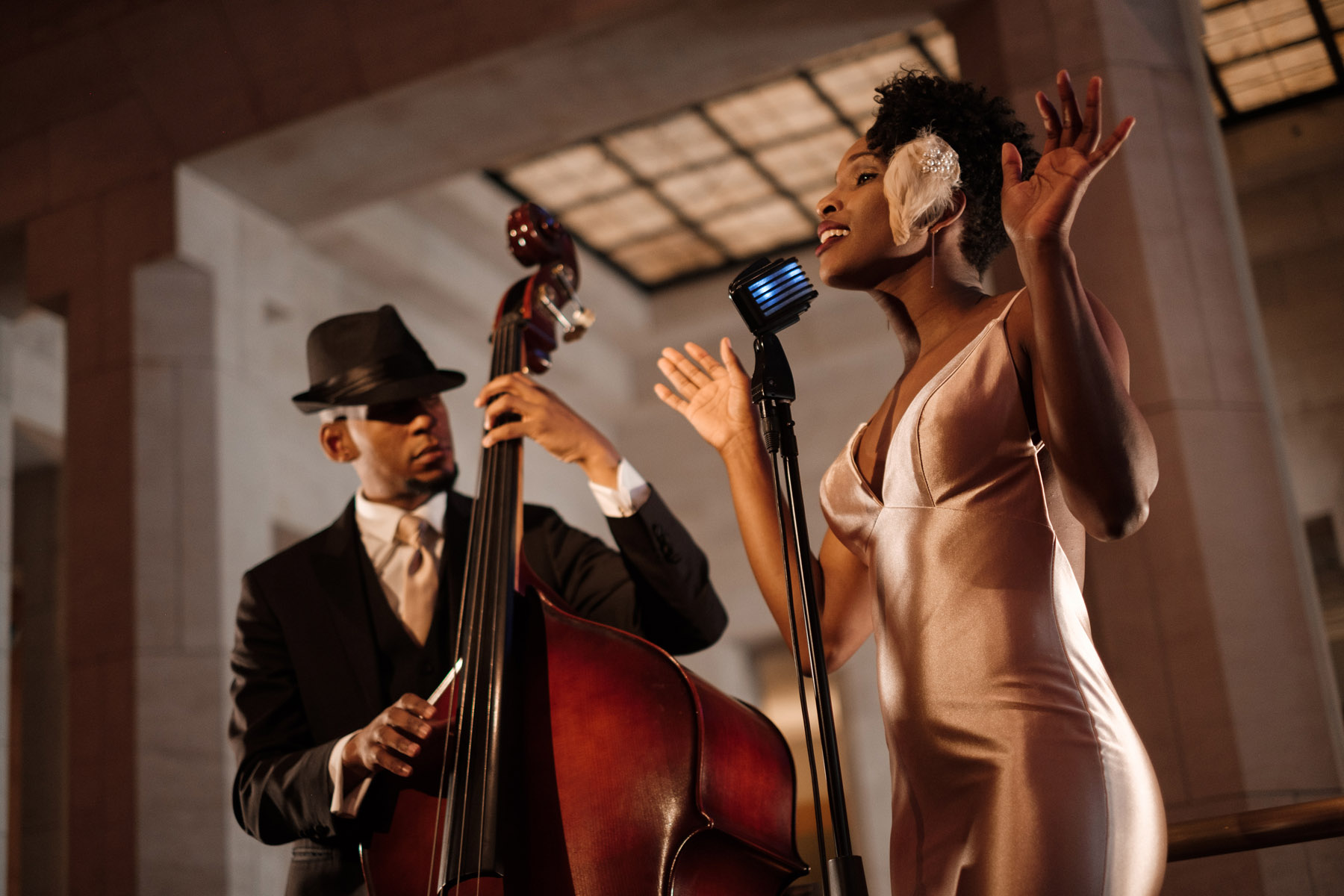
Courtesy of Acute Inflections

Audio By Carbonatix
A great deal of art is created to evoke the feeling of another time or place. Sometimes, a guitar riff can sound exactly like your 16th birthday, or the chorus of one song brings you back to the place where you met your last partner. It’s one of art’s superpowers, although it is typically only seen by the mind’s eye.
When it comes to the New York-based jazz and R&B duo, Acute Inflections, Sadiki Pierre and Elasea Douglas want you to actualize that feeling, physically and sonically sending you 100 years in the past to the peak of the Harlem Renaissance. Long before either of them was born, and likely decades before either of their parents was, counterculture in the 1920s and ’30s was defined by the Harlem Renaissance. Birthed in the underbelly of African American art in New York City, the music and cultural movement held court at low-ceiling rooms transformed into impromptu jazz spaces, where musicians and their artistic contemporaries gathered.
Those rooms were the stomping grounds of the earliest crop of recorded American music, where Duke Ellington, Ma Rainey and Cab Calloway performed for the likes of Langston Hughes and Charles Alston. At the moment, the movement was presented and contextualized in the same way that we’d talk about ’70s punk or the 2000s hardcore scene. Rowdy. Spontaneous. And deeply rooted in the underground.
But in the years following, jazz artists of the ’40s and ’50s took inspiration from the era’s sound, but not its aesthetics. Ella Fitzgerald wore a mink coat and performed at balls. Nat King Cole was a radio sensation. Billie Holiday carried herself with an elegance that would rival the Royal Family.
This year, make your gift count –
Invest in local news that matters.
Our work is funded by readers like you who make voluntary gifts because they value our work and want to see it continue. Make a contribution today to help us reach our $30,000 goal!
It’s this separation between the sonics and presentation of American jazz that Acute Inflections are attempting to bridge. They’re currently in the midst of their Soulful Sounds Tour, a nationwide barnstorm that doubles as a new roar for the long-lost 1920s. Their goal? Present jazz in the way it was first created, and in a way that nobody alivehass ever seen before. On Aug. 19, the duo hits Dallas, where we’ll get a chance to what some of these 100-year-old songs up close, plus a few of the duo’s originals.
“There’s still a stigma for jazz,” Pierre says over the phone. “Some people who are maybe less educated and haven’t had much experience with it, it seems like they assume that it might be corny.”
Pierre also notes that those who have stepped outside of their jazzy comfort zone on this tour have been pleasantly surprised. The music is timeless, clearly, but chalk it up to the setting, too.
“It’s not in a stuffy setting,” Douglas says of their shows. “Even if it’s an elegant place, the energy of the room and how things are laid out, the lighting just allows you to loosen your tie a little bit and be more comfortable with the night. If you think of the Harlem Renaissance, you’re thinking of low lights, sometimes chandeliers, velvet and things like that. If you go into an unconventional space, it kind of has that essence and it brings them back into a time.”
To a degree, Acute Inflections redesigns each room they perform in to match the aura of a ’20s party in Harlem’s underground. As such, performing in unconventional spaces is a priority for the two.
“We’re trying to get away from many of the venues that have live music every night,” Pierre says. “Those places have their own way of doing things. People oftentimes have been there before or know someone who’s been there before, and that creates an expectation of how it should be done. We want a blank canvas to recreate an experience that none of us were alive to experience 100 years ago. Having a venue that supports that and brings everybody in with a sense of wonder really helps us achieve that goal.”
For their Dallas stop, they’re playing at the Dallas Historical Society, an old museum building inside Fair Park. The aesthetics being transformed are one thing, but Acute Inflections remain contrarians at every turn. Both Douglas and Pierre mentioned a conscious effort to move away from the traditional, recognizable tropes of contemporary jazz.
“Nowadays it feels like most artists, when they do a solo, it’s something that they’ve practiced and went to college for and has been dissected,” Pierre says. “It just feels a little clinical. So on the musical front, for us to just go up there, sometimes we’re doing songs we’ve never done before live in front of an audience and putting our own spin on it.”
Douglas echoed Pierre’s sentiments, not only for the sake of a good show but also to accurately portray what jazz was like in the ’20s.
“Classic Harlem jazz means freedom, rebellion, play, sophistication, all while not taking yourself so seriously and being vulnerable,” Douglas says. “I think we started feeling more comfortable in that as artists when we got pushback. When we realized that the traditional jazz scene, aka the ‘jazz police,’ didn’t like how we were expressing jazz, didn’t like our boldness, didn’t like our out-of-the-box methods, didn’t like that we were dressing up, oddly enough, we affirmed that we were doing something right. It was making the gatekeepers uncomfortable, and we knew then that we were bringing it back to Harlem jazz.”
Acute Inflections will perform on Tuesday, Aug. 19, at 7 p.m. at Dallas Historical Society, 3939 E Grand Ave. Tickets are available starting at $55 for general admission and $90 for VIP on acuteinflections.com.